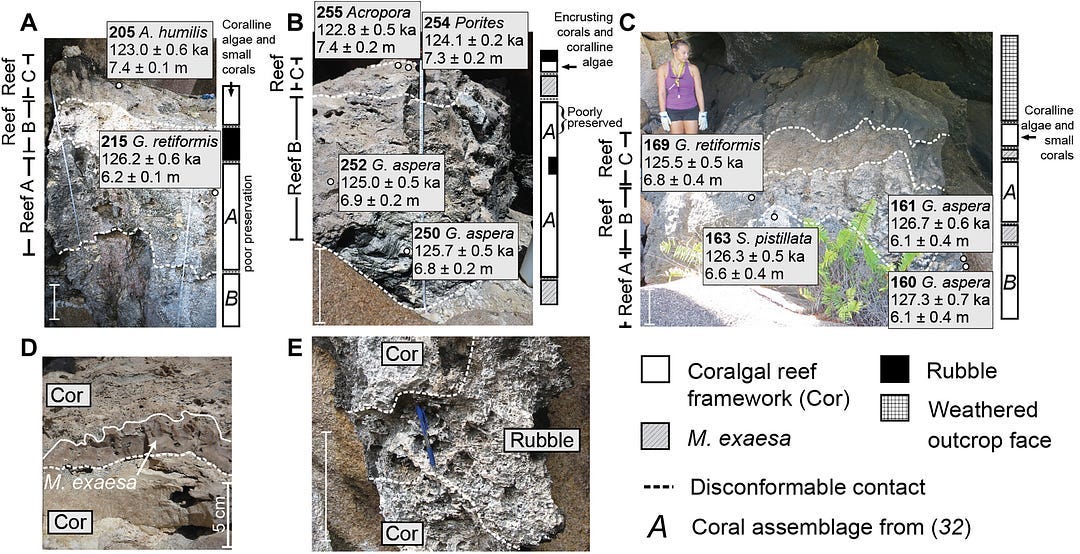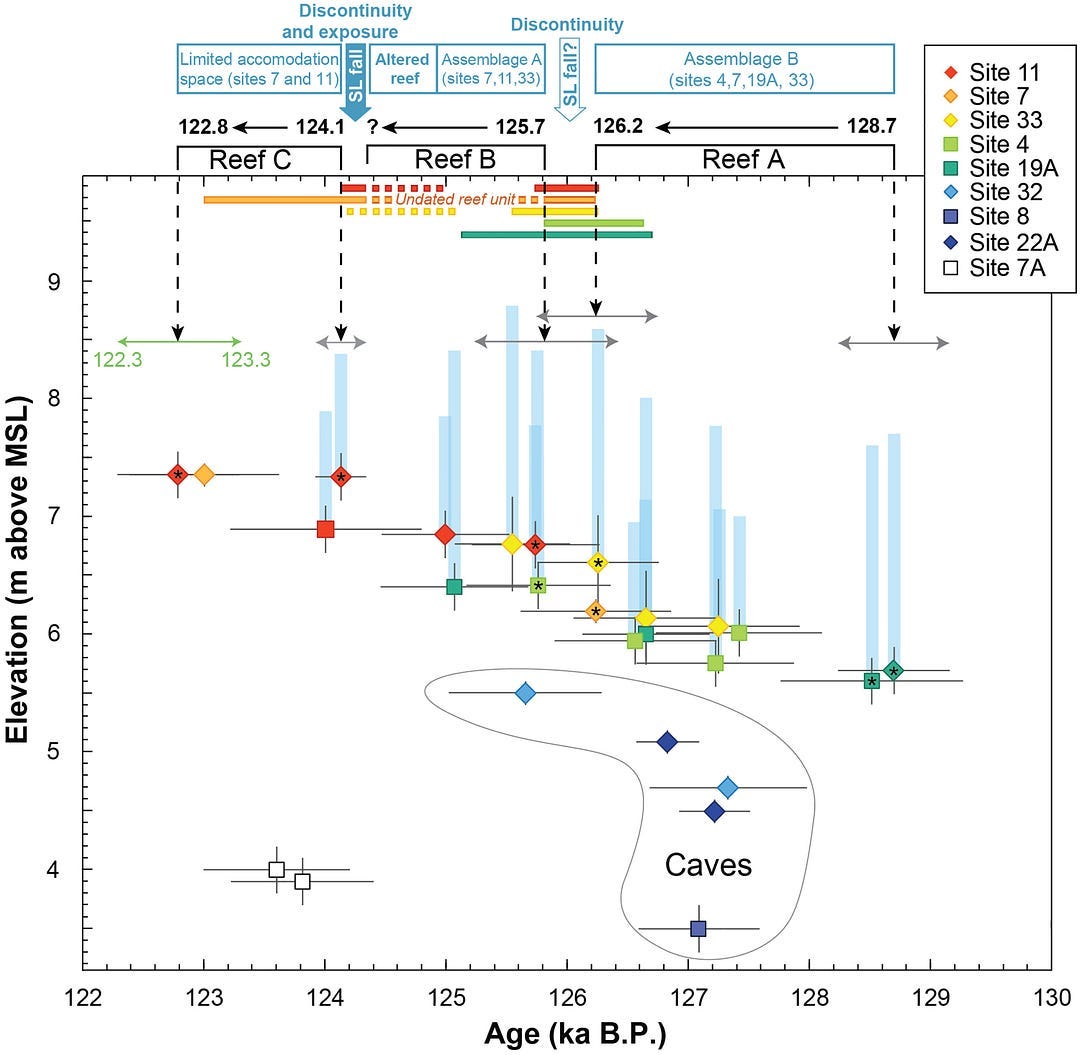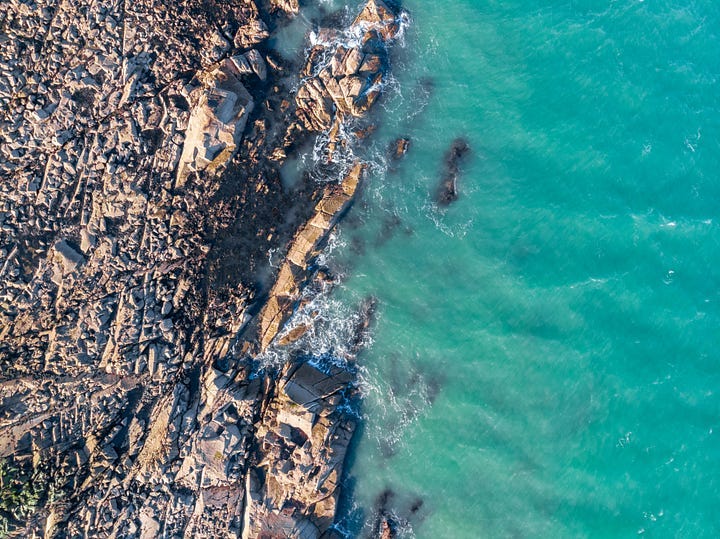Coral Secrets: A Sea-Level Warning 120,000 Years in the Making
Fossil corals from a remote island reveal how fast and unpredictably the oceans can rise
Have you ever seen fossil corals in the field? I bet you have, but it’s hard to spot them if nobody taught you how to identify them.
It was during my first paleontology course. We were crouched under the sun at an outcrop, notebooks in hand, and our professor pointed to a wall of 35-million-year-old reef rock. “This,” she said, “was once a living coral reef.”
Then she guided us through what we could learn just by looking: growth patterns, signs of storm destruction, even ancient symbiotic partnerships still visible in the stone. It was like reading the diary of an ancient sea.
Since then, every time I see fossil reef layers, my mind rushes to reconstruct what once was: the water depth, the shoreline, the temperature, the pulse of rising and falling seas. You do this long enough, and the rocks stop being silent. They speak in patterns.
In a new paper led by Dr. Karen Vyverberg and Dr. Andrea Dutton, the team studied fossil corals in the Seychelles (tiny islands in the Indian Ocean) to understand how sea levels changed during the Last Interglacial, a warm period roughly 129,000 to 116,000 years ago.
What they found adds urgency to our current climate conversations.
What do those fossil reefs reveal? It’s not the slow, predictable sea-level rise we sometimes imagine. It’s fast, dramatic pulses (up and down) on the scale of human generations. And that matters more now than ever.

But how did they perform the study, and why does this matter?
The Last Interglacial is often used as a reference point for today’s warming world. Temperatures were similar, polar regions were warmer, and sea levels were significantly higher than they are now. If we want to understand how ice sheets might behave as our planet heats up, this period offers critical clues.
What makes the Seychelles special is that it’s far from where the massive ice sheets used to sit. That means the corals there recorded global sea-level changes without much distortion from local effects like land rebounding or ice-sheet gravity.
By dating 24 coral samples (using a technique that’s basically a geological stopwatch), they built one of the most precise records of ancient sea-level change to date.

The team used 230Th dating, a method that tells us how old the coral is by measuring how much thorium has formed from uranium decay inside it.
But the real magic came from combining this dating with sediment analysis.
That let them figure out not just when the corals grew, but why they stopped and started. Sharp breaks in the reef record, layers of rubble, and evidence of exposure above water told a story of sea levels that didn’t just rise: they surged, paused, fell briefly, and surged again.
And what did they find?
Between 129,000 and 123,000 years ago, sea levels rose at least three separate times, each punctuated by a sudden drop. These weren’t gentle changes. Some happened in less than 500 years.
Imagine being a coastal dweller then: your shoreline disappearing and returning, again and again, within a few generations. At one point, sea level rose to 7.4 meters (about 24 feet) above where it is today.
That’s already staggering, but here’s where things get interesting: These pulses weren’t synced up.
The Antarctic and Greenland ice sheets weren’t melting together. They were taking turns. When one was melting, the other might be regrowing. This kind of out-of-phase behavior masked the full extent of ice sheet vulnerability. If they had both collapsed at the same time? Sea level might have risen even higher.

Today, however, that’s exactly what’s happening. Both poles are warming and melting together.
As Dr. Andrea Dutton put it: “If temperature rises simultaneously in both hemispheres as it is today, then we can expect future sea level rise to be even greater than it was back then.”
But what does this mean for us?
This study challenges the idea that sea-level rise will be gradual or smooth. The past shows us that ice sheets can behave like flicked dominoes, tipping suddenly, with outsized consequences under warming conditions like ours.
It also suggests we may be underestimating how much ice loss is “baked in” already. Dr. Vyverberg and colleagues write that what we’re seeing now could easily lead to a global average rise of up to 10 meters in the long run, just from warming that has already occurred.
Ten meters would swallow many coastal cities. But the key word here is “long run.” This isn’t happening tomorrow. The pace depends on how quickly ice sheets respond and how quickly we act.

So, here are my final thoughts.
Corals can’t run. Because they need sunlight for their symbiotic algae, they grow right at the edge of where land meets sea, building up as the ocean rises around them. When the sea level surges too fast (or drops abruptly), they die. In the fossil record, we see that vulnerability in reef after reef: vibrant growth, sudden collapse, and then a slow recovery… if there’s time.
That vulnerability mirrors our own. Unlike corals, we can adapt. We can strengthen infrastructure, reduce emissions, and make choices that ease the future for the generations coming after us.
But first, we have to listen.
The fossil reefs of the Seychelles are speaking again. And their message is clear: the seas won’t wait for us to catch up.
Do you want to read more stories like this? You can now subscribe to my newsletter and join a community of over 11,000 Earth lovers!
I’m thrilled you’re here. Stay curious, and thank you for sharing this journey with me!
Best,
Sílvia P-M, PhD Climate Ages






Thank you for this excellent explanation. I’m working on a book for young readers about climate and migration and your articles give me the courage to tackle the huge, difficult topics I’m trying to pin down.
You explain these things so lucidly and so beautifully:
"This study challenges the idea that sea-level rise will be gradual or smooth. The past shows us that ice sheets can behave like flicked dominoes, tipping suddenly, with outsized consequences under warming conditions like ours."
You did a great thing for humankind by leaving the too-narrow world of academic research to talk to everyone.